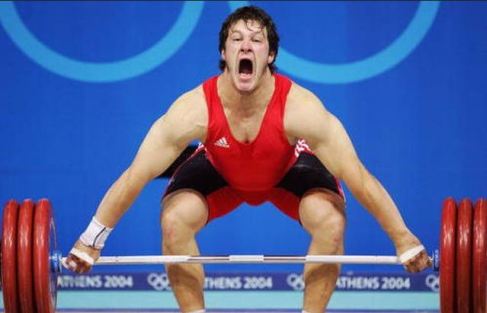Don’t Be a Slacker
by coachdanbell
Mark Cameron, still the lightest American ever to Clean & Jerk over 500 pounds (227.5 kilos to be exact) told me something over breakfast at Nationals a few years ago that I have never forgotten. “The lift doesn’t start when the bar comes off the floor.” From the moment your hands touch the bar to the instant it breaks from the floor you are engaged in a deliberate process. It may be quick, but it is not sudden.
The process involves going from having none of the weight of the barbell in your hands to all of it as it comes off the floor. The beginning of this is what I call “taking out the slack.” If you pull on any bar loaded with plates, even very expensive and well made bars and plates, you will hear an audible metallic click. That’s the sound of the bar closing the gap between the sleeve and the metal liner of the hole in the plate. You have begun taking the weight in your hands by lifting just the bar. (If you hear that click just as the bar breaks from the floor, you are probably jerking it off the floor and threatening to lose all-important position) The next step is to start tightening your back against the pressure in your hands. If you start with your hips high, you’ll drop your hips, lift your chest and begin arching your back. This will pull more of the weight of the bar in your hands and, if you get your hips as low as they should be, the increasing load will transfer to your legs and put pressure in your feet.
It works more or less the same way if you start with your hips low and back loose, pushing up to get the slack out, then arching your back to take more weight in your hands. In either case, you should look like this just before the bar breaks from the floor.
The important thing to notice about “taking out the slack” is that you are using the weight of the bar to work against while tightening your back. If you simply arch your back against no resistance–no weight in your hands to pull against–your back will not be adequately prepared to hold position when the bar breaks from the floor. Most lifter’s backs will give at least a little as the entire load comes suddenly into their hands and back. That will cause the bar to move straight up or even away from the lifter as it leaves the floor, rather than moving back toward the lifter as it should.
Too many lifters rip the bar off the floor without this deliberate process of preparing the back to transfer the load to the legs and feet. We are taking what is essentially the most flexible part of our frame–the spine–and by properly “taking out the slack” making it into a rigid conduit through which the load in our hands is conveyed to our legs and feet.
You can’t be lazy or sloppy about the process of getting the weight off the floor. If you are it will get back to the floor a lot sooner than you’d like. Maybe your back won’t look like this when you tighten it against the bar, but you should at least have this kind of effort in mind.
Don’t be a slacker; take out the slack.
(I hope Rob Macklem will not mind the use of his photos for this. He’s one of the best weightlifting photographers out there.)


